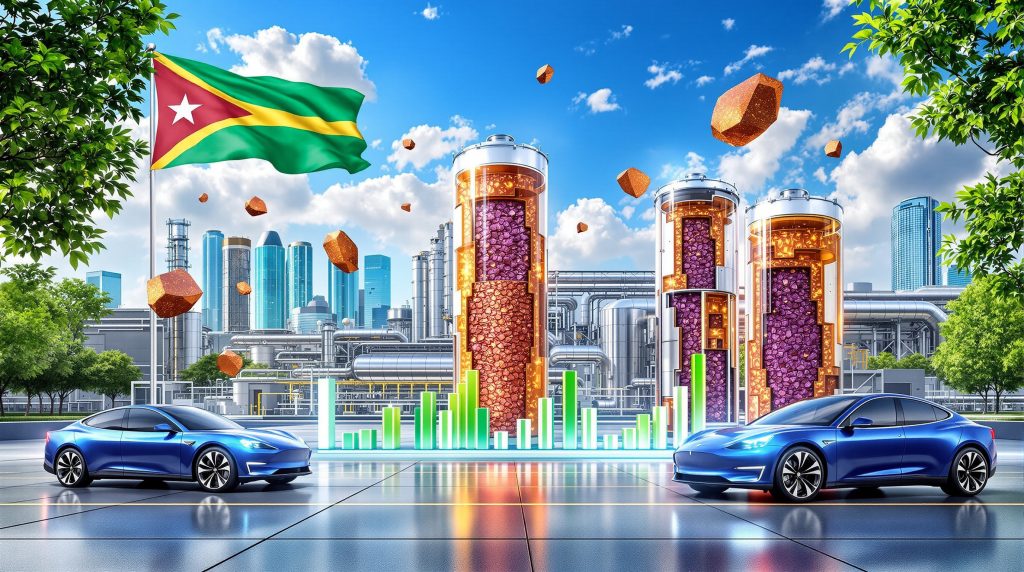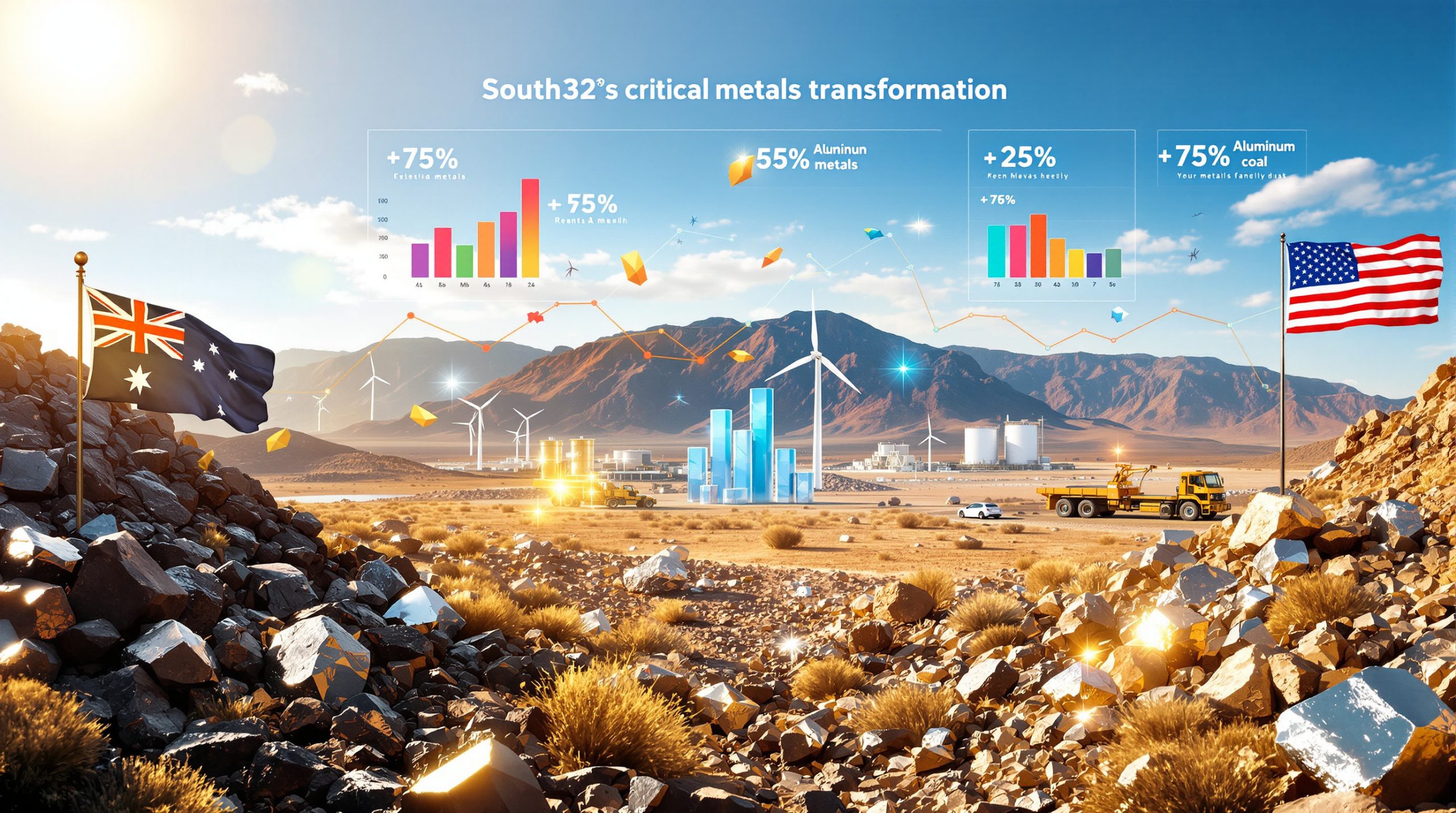Understanding the Breakthrough: What Phase 1 Battery Qualification Actually Means
Battery qualification testing represents a critical gateway for materials suppliers seeking to enter the EV supply chain. When Giyani Metals' manganese product passes first phase of US battery qualification tests with C4V, they achieved a milestone that validates both their production capabilities and product specifications against rigorous industry standards.
The Technical Standards Behind Battery-Grade Manganese Testing
Modern mining technology in battery qualification programs evaluates multiple electrochemical properties through comprehensive coin cell analysis. According to the U.S. Department of Energy's Battery Materials Research initiative, these assessments examine first cycle efficiency (typically 85-95% for commercial-grade manganese materials), capacity retention (minimum 80% after 500 cycles for automotive applications), and energy density requirements ranging from 150-250 Wh/kg for EV applications.
The coin cell testing methodology follows International Electrotechnical Commission standards, involving:
- Half-cell configuration using lithium metal counter electrode
- Voltage window of 2.0-4.3V for manganese-based cathodes
- Current density testing from C/10 to 1C rates
- Temperature control at 25°C ± 2°C
- Test duration minimum of 100 cycles for Phase 1 screening
As reported in Mining Weekly on October 21, 2025, C4V's evaluation confirmed that Giyani's HPMO meets required Phase 1 criteria for electrochemical properties including first cycle efficiency, capacity, charge/discharge efficiency, and density specifications.
Why Independent Third-Party Validation Matters for Mining Companies
Independent qualification through established battery technology companies provides crucial market credibility that laboratory-scale testing cannot deliver. Furthermore, this validation process demonstrates that controlled production environments can translate into consistent, commercial-grade materials meeting industry specifications across multiple performance metrics.
Nigel Robinson, Giyani's interim executive chairperson, emphasised this significance, stating that the Phase 1 results represent an important milestone enabling the company to demonstrate their HPMO product not only meets specifications but also performance criteria through independent coin cell analysis, contributing to ongoing offtake discussions.
The battery industry commonly employs staged qualification programs similar to C4V's Digital DNA Supply Chain Qualification Program. Tesla's supplier qualification process involves 3-4 phases over 18-24 months, while Korean battery manufacturers like LG Energy Solution and Samsung SDI utilise comparable multi-phase validation approaches, with each phase escalating from material characterisation to full cell testing.
How Does Giyani's Johannesburg Demo Plant Compare to Traditional Production Methods?
Giyani's demonstration plant in Johannesburg represents a critical intermediate step between laboratory research and commercial production, producing HPMO at kilogram scale rather than the gram quantities typical of laboratory testing. In addition, this scale-up demonstrates technical viability while maintaining stringent quality standards demanded by battery manufacturers.
Proprietary Hydrometallurgical Process Advantages
Traditional manganese production relies on pyrometallurgical smelting to produce electrolytic manganese dioxide (EMD) or electrolytic manganese metal (EMM), primarily serving steel and ferroalloy applications. However, Giyani's specialised hydrometallurgical approach targets the exceptional purity levels required for battery cathode precursor materials.
According to the U.S. Geological Survey's Mineral Commodity Summaries, battery-grade manganese requires 99.9%+ purity for high-purity manganese oxide applications. Hydrometallurgical processing offers distinct advantages including lower energy consumption, superior purity control, and reduced CO2 emissions compared to traditional smelting methods.
The International Manganese Institute specifications for battery-grade innovations include:
- Particle size distribution with D50 of 2-10 micrometers
- Impurity limits: Fe <50ppm, Ca <50ppm, Mg <50ppm, Na <50ppm
- Specific crystal structure polymorphs required for electrochemical performance
Demonstration-Scale Production vs Laboratory Testing
| Production Scale | Volume Capacity | Quality Consistency | Commercial Viability |
|---|---|---|---|
| Laboratory Scale | 1-100 grams | Variable | Research only |
| Demo Plant Scale | 1-100 kilograms | Standardised | Market validation |
| Commercial Scale | 1,000-10,000 tonnes/year | Industrial grade | Full supply chain |
According to S&P Global Market Intelligence research on critical minerals processing, demonstration plants bridge the gap between controlled laboratory conditions and commercial viability, proving processes can be replicated at meaningful production volumes while maintaining quality consistency.
The Mining Weekly report confirmed that HPMO used in C4V's qualification program was produced at Giyani's demonstration plant rather than laboratory scale, with additional quantities planned for subsequent testing phases.
What Are the Next Phases in C4V's Digital DNA Supply Chain Program?
C4V's qualification program follows a structured progression designed to evaluate materials under increasingly demanding conditions that simulate real-world battery applications. Consequently, the successful completion of Phase 1 coin cell testing positions Giyani for more comprehensive validation stages.
Phase 2 Testing Requirements and Timeline
Phase 2 testing involves single-layer pouch cell evaluation over approximately five months, focusing on long cycling performance, cycling stability, and rate capability assessment. This stage moves beyond basic material properties to examine real-world battery performance characteristics under controlled conditions.
According to International Electrotechnical Commission standards, single-layer pouch cell testing typically involves:
- Cell capacity of 1-5 Ah
- Cycle life testing through 500-1000 cycles minimum
- Rate capability evaluation at C/5, C/2, 1C, and 2C discharge rates
- Temperature range testing from -20°C to 60°C
- Safety testing including overcharge, over-discharge, and short circuit scenarios
Phase 3 Multi-Layer Validation Process
The final six-month Phase 3 evaluation involves multi-layer pouch cell testing under conditions closely simulating actual electric vehicle battery pack environments. This comprehensive stage ensures materials perform consistently across complex battery architectures.
Multi-layer pouch cells typically feature:
- Cell capacity of 20-100 Ah (approaching commercial EV cell sizes)
- Stack configuration with 10-30 layers
- Additional testing for mechanical stress, thermal management, and cell-to-cell variation
Baasit Ali, C4V's supply chain VP, expressed encouragement with Phase 1 results, noting that Giyani's HPMO demonstrated promising performance during internal evaluation and aligns well with their material and electrochemical standards, with anticipation for advancing through subsequent qualification phases.
Why Is Battery-Grade Manganese Becoming Critical for Electric Vehicle Growth?
The electric vehicle industry's transition toward high-manganese battery chemistries represents a fundamental shift driven by cost optimisation and performance improvements. For instance, this evolution positions manganese as increasingly critical for sustainable EV growth through the late 2020s, particularly given the critical minerals energy transition.
The Shift Toward High-Manganese Battery Chemistries
According to Benchmark Mineral Intelligence projections, global manganese sulfate demand for batteries is expected to reach approximately 500,000 tonnes by 2030, compared to current capacity of roughly 200,000 tonnes in 2024. This represents a compound annual growth rate of 25-30% through 2030, with a significant supply gap emerging during the 2027-2030 period.
Key Market Dynamics:
The International Energy Agency reports that lithium iron phosphate (LFP) batteries held 35% global market share in 2023, while emerging lithium manganese iron phosphate (LMFP) chemistries are projected to capture 15-20% market share by 2030. High-manganese NCM chemistries, including NCM622 and NCM811 formulations, continue gaining adoption among automotive manufacturers.
Economic Advantages:
Research published in Nature Energy demonstrates manganese's cost advantages, with manganese trading at $2-3/kg compared to nickel at $16-18/kg and cobalt at $30-35/kg. High-manganese cathodes also exhibit improved thermal stability and safety characteristics while delivering competitive energy density.
Supply Chain Diversification Beyond China
Current battery material supply chains remain heavily concentrated in Chinese production facilities, creating strategic vulnerabilities for Western automotive manufacturers. Dr. Kwasi Ampofo from BloombergNEF noted in a 2024 report that manganese is positioned to become one of the most supply-constrained battery materials in the late 2020s, emphasising the critical need for supply chain diversification.
Global EV Production Forecasts:
BloombergNEF projects global EV sales growing from 14 million vehicles in 2023 to 40-50 million vehicles by 2030, requiring battery capacity of 3,500-4,000 GWh annually. This expansion implies manganese demand of 1.2-2.0 million tonnes annually, highlighting the scale of supply chain transformation required.
What Does This Mean for Giyani's K.Hill Project Development Timeline?
The successful Phase 1 qualification provides crucial validation supporting Giyani's progression toward their Botswana-based K.Hill project. Furthermore, this technical milestone strengthens the commercial foundation necessary for advancing definitive feasibility studies and securing project financing.
From Demo Plant Success to Commercial Production
According to engineering consultant Hatch Ltd's published guidance on scaling battery materials production, the typical progression from demonstration to commercial scale involves scale-up factors of 50-100x. A demonstration plant producing 10 kg/day could target commercial production of 500-1000 kg/day, equivalent to 150-300 tonnes annually.
Development Timeline Considerations:
Engineering industry standards suggest 2-3 years from Final Investment Decision to first production for hydrometallurgical plants, with capital intensity ranging from $5,000-15,000 per tonne annual capacity. The Government of Botswana's Ministry of Mineral Resources supports value-addition processing through their Green Economy Strategy, providing favourable investment conditions for critical minerals projects.
Parallel Offtake Process Development
Robinson emphasised that Phase 1 qualification success contributes to ongoing offtake discussions proceeding parallel to the qualification program. This simultaneous development approach optimises commercial timeline efficiency while building customer relationships based on proven technical performance.
Regional Context:
Botswana ranks as Africa's second-largest manganese ore producer after South Africa, with established mining infrastructure and government policies supporting critical minerals development. This positioning provides strategic advantages for supply chain diversification initiatives by Western automotive manufacturers.
How Do HPMO Products Fit Into Modern Battery Manufacturing?
High-purity manganese oxide serves as a critical precursor material in cathode production for lithium-ion batteries, with its purity levels and electrochemical properties directly influencing final battery performance, energy density, and operational lifespan in electric vehicle applications.
High-Purity Manganese Oxide Applications
According to the World Economic Forum's Battery Supply Chain report, modern battery manufacturing follows a structured progression:
- Stage 1: Raw material mining (manganese ore containing 25-50% MnO)
- Stage 2: Refining to battery-grade products (HPMO achieving 99.9%+ purity)
- Stage 3: Precursor cathode active material (CAM) production
- Stage 4: Cell manufacturing and assembly
HPMO's role in Stage 2 requires exceptional chemical purity and specific particle size distributions to ensure consistent electrochemical performance throughout the battery manufacturing process.
Integration with Energy Storage Systems
Beyond electric vehicles, HPMO applications extend to large-scale energy storage systems supporting renewable energy infrastructure. These stationary storage applications often feature different performance requirements compared to automotive batteries, including:
- Extended cycle life requirements (10,000+ cycles vs 1,000-3,000 for EVs)
- Lower energy density priorities in favour of cost optimisation
- Different thermal management and safety considerations
This diversification creates multiple market opportunities for high-purity manganese producers, reducing dependence on automotive sector growth while supporting broader energy transition objectives.
What Competitive Advantages Does This Qualification Provide?
Independent qualification through C4V's program positions Giyani advantageously among non-Chinese manganese suppliers as the industry seeks supply chain alternatives. Few companies outside China currently produce high-purity manganese oxide at demonstration scale with verified electrochemical performance.
Market Positioning Among Non-Chinese Suppliers
The qualification success provides objective performance data supporting discussions with additional battery technology companies and automotive manufacturers. This technical validation reduces perceived risk for potential partners evaluating new supplier relationships in an industry where proven capability carries significant weight.
Comparable Development Projects:
- Manganese X Energy (Canada): Operating demonstration plant since 2022, targeting commercial production 2025-2026
- Euro Manganese (Czech Republic): Completed preliminary feasibility study 2019, definitive feasibility study 2021, targeting 2026 production
Technical Validation for Future Partnerships
C4V's independent validation demonstrates that Giyani's proprietary hydrometallurgical process can consistently produce materials meeting battery industry specifications. This third-party confirmation strengthens the company's position in commercial negotiations and partnership discussions.
The successful progression through C4V's qualification program also provides a template for similar evaluations with other battery technology companies or automotive manufacturers, potentially accelerating customer development timelines.
What Are the Broader Implications for Battery Material Supply Chains?
Giyani's demonstration plant success in South Africa contributes to broader geographic distribution of critical mineral processing capabilities, supporting global supply chain diversification objectives throughout the battery materials sector.
Geographic Distribution of Critical Mineral Processing
Successful development of manganese processing capabilities in Africa helps reduce concentration risk in critical mineral supply networks supporting the electric vehicle transition. This geographic diversification aligns with strategic objectives of Western automotive manufacturers and battery producers seeking alternatives to China-dominated supply chains.
Supply Chain Resilience Benefits:
- Reduced single-country dependency for critical materials
- Enhanced supply security through geographic distribution
- Lower transportation costs for some regional markets
- Political risk mitigation through supplier diversification
Timeline Alignment with EV Industry Growth
Giyani's development timeline potentially synchronises with projected increases in electric vehicle production and corresponding battery material demand growth. The estimated completion of C4V's qualification program by September 2026 aligns with the 2027-2030 period when industry analysts project significant supply gaps emerging in battery-grade manganese markets.
This timing coordination could position the company favourably as markets expand through the late 2020s, particularly if additional qualification programs with other customers proceed simultaneously.
How Does This Development Impact Investment Considerations?
Independent qualification results reduce technical uncertainty surrounding Giyani's product development capabilities while providing investors with objective performance data supporting the company's commercial development strategy.
Technical Risk Reduction Through Validation
C4V's qualification program represents independent verification that Giyani Metals' manganese product passes first phase of US battery qualification tests meets industry standards for electrochemical performance. This third-party validation addresses technical risk concerns that investors typically associate with early-stage materials companies transitioning from research to commercial applications.
Key Risk Mitigation Factors:
- Demonstrated product performance at demonstration scale
- Independent third-party validation of technical capabilities
- Proven ability to meet industry qualification standards
- Established pathway for customer development and commercial relationships
Market Access and Customer Development
Successful qualification opens pathways to additional customer discussions and potential supply agreements. These commercial opportunities represent key value drivers for investors evaluating long-term prospects, particularly as the qualification program progresses through more comprehensive testing phases.
The parallel development of offtake discussions, as noted by Robinson, suggests potential for commercial agreements emerging alongside technical validation, providing multiple value catalysts over the 11-month qualification timeline.
What Should Industry Observers Watch for Next?
The progression through subsequent qualification phases will provide increasingly detailed performance data, with success in advanced testing stages further validating Giyani's product development approach and commercial viability.
Phase 2 and Phase 3 Testing Outcomes
Phase 2 single-layer pouch cell testing over the next five months will evaluate long-term cycling performance, stability, and rate capability under conditions more closely approximating real-world battery applications. Success in this phase would demonstrate material performance beyond basic electrochemical properties.
Phase 3 multi-layer pouch cell testing represents the most demanding validation stage, simulating actual electric vehicle battery pack environments. Successful completion would provide comprehensive performance validation supporting commercial supply discussions.
Additional Customer Qualification Programs
Expansion into qualification programs with other battery technology companies or automotive manufacturers would demonstrate broader market acceptance while reducing customer concentration risk. The template established with C4V could potentially accelerate similar programs with additional potential customers.
Key Milestones to Monitor:
- Phase 2 completion and results (approximately March 2026)
- Phase 3 initiation and progress updates
- Additional customer qualification program announcements
- K.Hill project development milestones and financing progress
- Offtake agreement developments and commercial partnerships
Positioning for the Next Phase of Battery Material Development
Giyani Metals' manganese product passes first phase of US battery qualification tests represents more than a technical milestone – it validates their strategic approach to developing independent, Western sources of critical battery materials. As the electric vehicle industry continues expanding and seeking supply chain diversification, companies demonstrating proven technical capabilities and independent validation gain significant competitive positioning.
The progression through C4V's remaining qualification phases will determine whether this early success translates into commercial supply relationships. However, the independent validation already achieved provides crucial credibility in an industry where technical performance and supply reliability remain paramount considerations for automotive manufacturers and battery producers.
Industry Context and Future Outlook:
With global EV production projected to triple by 2030 and high-manganese battery chemistries gaining adoption, the timing of Giyani's qualification success aligns with emerging market demand. The company's demonstration plant capabilities, combined with the strategic location of their K.Hill project in Botswana, positions them to capitalise on supply chain diversification trends as the battery materials sector continues evolving.
The broader implications extend beyond individual company success to encompass strategic supply chain development for the global energy transition. Independent qualification programs like C4V's Digital DNA initiative provide crucial validation mechanisms enabling new suppliers to enter established markets while maintaining the technical standards essential for electric vehicle performance and safety. Furthermore, this development reinforces the importance of the battery recycling breakthrough initiatives being developed globally to support circular economy principles.
Disclaimer: This article contains forward-looking statements and projections based on current market analysis and industry reports. Battery material markets, electric vehicle adoption rates, and company development timelines are subject to various risks and uncertainties that could cause actual results to differ materially from those projected. Investors should conduct their own due diligence and consider all risk factors before making investment decisions.
Looking for ASX Opportunities in Battery Materials?
Discovery Alert's proprietary Discovery IQ model delivers real-time alerts on significant battery materials and critical minerals discoveries, instantly empowering subscribers to identify actionable opportunities ahead of the broader market. Begin your 30-day free trial today at Discovery Alert and secure your market-leading advantage in this rapidly expanding sector.




